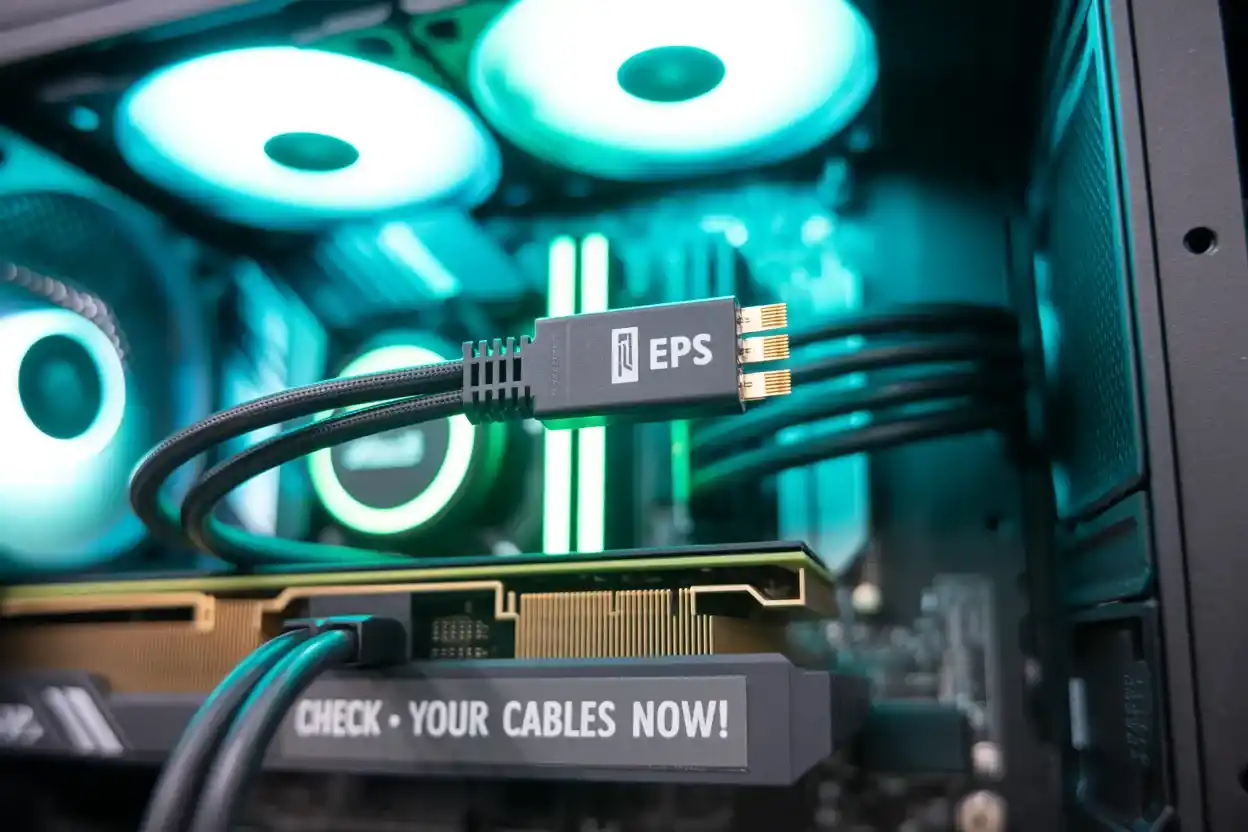No, you cannot use an EPS cable for a GPU. EPS cables are made to give power to the CPU, not the graphics card. A GPU needs a PCIe cable for safe power. Using the wrong cable can harm your GPU or power supply. Always connect the right cable.
We will explain what an EPS cable is, why it should not be used for a GPU, and how using the wrong cable can harm your PC.
What Is an EPS Cable?
An EPS cable is a power cable that connects the power supply unit (PSU) to the CPU on the motherboard. It normally comes in a 4+4 or 8-pin design. Its main job is to give stable and strong power to the processor. It is not made for graphics cards, so never use it for powering a GPU. Doing so can cause serious hardware damage.
EPS Cable vs. PCIe Cable
| Feature | EPS Cable (CPU) | PCIe Cable (GPU) |
| Purpose | Powers the CPU | Powers the GPU |
| Pin Layout | 4+4 or 8 pins | 6, 8, or 6+2 pins |
| Wiring | CPU-specific wiring | GPU-specific wiring |
EPS cables and PCIe cables may look similar, but they are designed for completely different parts of the computer. Using the wrong one can cause failure or permanent damage.
GPU Power Requirements
A GPU needs a specific amount of power and the correct type of cable to work safely. Most modern GPUs use 6-pin, 8-pin, or 6+2-pin connectors. High-end GPUs may need more than one connector or even new 12-pin or 16-pin cables. If the power supply or cable does not meet the GPU’s needs, you may face crashes, poor performance, or permanent damage. Always check your GPU manual before connecting cables.
Is Using an EPS Cable Safe for GPUs?
It is not safe to use an EPS cable for a GPU. Even though the connectors may look similar, the wiring and voltage are different. Using an EPS cable on a GPU can lead to short circuits, overheating, or complete GPU failure. Always use a PCIe cable that is made specifically for graphics cards.
Risks of Using an EPS Cable
- Permanent damage to the GPU
- Damage to the power supply
- Short circuit and sparks
- Overheating during heavy use
- Voiding your GPU warranty
These risks make it clear that EPS cables should only be used for CPUs, never for GPUs.
Finding the Right GPU Cable

To find the right cable, check your GPU’s power connector type. Most use 6-pin, 8-pin, or 6+2-pin PCIe cables. Some high-end GPUs now use 12-pin or 16-pin connectors. Always use original cables from your PSU brand or certified replacements. This ensures safe power delivery and longer GPU life.
Types of GPU Power Connectors
- 6-pin – Older or low-power GPUs
- 8-pin – Common for mid to high-end GPUs
- 6+2-pin – Works as both 6-pin and 8-pin
- 12-pin / 16-pin – For latest high-power GPUs
Choosing the correct connector ensures safe operation and prevents damage.
Checking PSU and GPU Compatibility
Before connecting your GPU, make sure your power supply has the right connectors and enough wattage. For example, if your GPU needs two 8-pin connectors, your PSU must have them available. The PSU wattage should be higher than the GPU’s total power draw to avoid instability or sudden shutdowns.
Using an EPS Cable with an Adapter
Some adapters can change EPS to PCIe, but this is risky. The wiring inside is still different, and the adapter may heat up or fail under heavy load. Using an adapter can also damage your GPU. It’s always best to use the proper PCIe cable from your PSU.
Safe GPU Power Connection Tips
- Use only original cables from your PSU manufacturer
- Match the connector type exactly to your GPU port
- Avoid mixing PSU cables from different brands
- Keep cables neat and secure to avoid loose connections
- Check PSU wattage before installing a powerful GPU
Fixing GPU Power Cable Issues

If your GPU is not turning on or showing a display, check the power cable connection. Make sure the connector is fully locked into place. Replace damaged or burned cables immediately. If your PSU is old or does not have the right connectors, upgrade it to a model with proper PCIe outputs.
Understanding GPU Power Cable Specifications
GPU power cable specifications tell you the cable type, connector size, and how much power it can carry. Always match the cable type with your GPU’s needs. Using the wrong cable can cause damage or low performance. Check your GPU and PSU manuals for the correct cable details.
FAQs
1. Why Do EPS Cables Look Similar to GPU Cables?
EPS and GPU cables look similar because both have 8-pin connectors, but the pin layout and wiring are different.
2. How Can I Tell if My Cable is Safe for a GPU?
Check the label on the cable or PSU port — GPU cables are marked PCIe, not EPS.
3. Can EPS Cables Damage a GPU?
Yes, using an EPS cable can damage the GPU because of the different power wiring.
4. Is It Okay to Use Any PSU Cable for a GPU?
No, only use cables made for PCIe ports to avoid damage or power issues.
5. Can a Wrong Cable Reduce GPU Performance?
Yes, wrong cables can cause unstable power, leading to lower performance or shutdowns.
Conclusion:
Using the right power cable for your GPU is important for safety and performance. EPS and PCIe cables look similar but have different wiring. Using an EPS cable for a GPU can cause overheating or damage. Always use the correct PCIe cable to match your GPU’s needs and keep your system safe.

